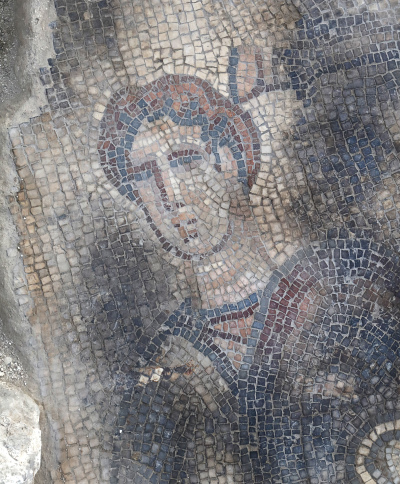Archeologists uncover mosaic depicting biblical Samson at ancient Israeli synagogue

A mosaic panel depicting biblical stories uncovered at an ancient synagogue was discovered by archeologists seeking answers about the impact of early Christian rule on Jewish people.
Jodi Magness, an archaeologist and professor of early Judaism at the University of North Carolina Chapel Hill, has been excavating the synagogue in the ancient Jewish village of Huqoq since 2011. The village is located in Israel's Lower Galilee.
Magness and her team discovered the first set of mosaics in 2012 after their excavation progressed to the floor of the building.
The mosaic panels on the synagogue floor depict biblical stories, including Samson and the foxes from Judges 15:4 and Samson carrying the gates of Gaza as in Judges 16:3. This summer, additional sections of those mosaic panels were exposed.
A newly discovered mosaic on the floor just inside the main entrance consists of a large panel with a Hebrew inscription contained inside a wreath. An Aramaic inscription lists the names of what appear to be the donors who funded the mosaic or the artists who created them. Other panels depict a tiger hunting an ibex, while another features a Philistine horseman and a dead Philistine soldier.
In a Thursday interview with The Christian Post, Magness said the discovery of the mosaic was unintentional. Every summer, her team uncovers more mosaics, never knowing what to expect.
"But like other sciences, archeologists usually start with a goal of answering one or more research questions in the hopes that the remains that we dig up will help us to answer those questions," the professor told CP.
The professor said that the number of people working on the project varied yearly, but this year, the team consisted of around 50 people. Regarding the funding for the project, Magness said that it also came from multiple sources that varied from year to year.
Magness said she sought to answer questions about the fate of Jewish villages under early Christian rule through the excavation. The village of Huqoq existed during the Roman and Byzantine periods, the professor said. And beginning in the fourth century, the Roman Empire became Christian.
"Many of my colleagues in Israel think the Christian rule was oppressive to Jews and that many of these settlements declined and even disappeared during the fourth, fifth and sixth centuries," Magness said. "And my impression from the archeology was always exactly the opposite, that these Jewish settlements continued to exist and even to flourish."
The archaeologist said the discovered remains indicate that Huqoq did "flourish" during the fourth, fifth and sixth centuries. While she acknowledged that the same may not be true for every settlement, at least with Huqoq, Magness believes the remains support her view.
Another question that Magness sought to answer was the dating of the Galilean-type synagogue, which has typically been dated to the second and third centuries A.D.
"And I think, based on the dating provided by associated artifacts of pottery and coins found in association with the construction of the building, I think that the archeological evidence indicates that this type of synagogue building dates to the fourth, fifth and sixth centuries," she said. "And this is significant because if they were built in the second or third centuries, that's a pagan Roman context, and if it's the fourth and the sixth century, it's the Christian context."
Magness said the findings have implications for understanding the fate of Jews and the fate of Jews after Christian rule, as well as relations between members of the two religions.
Now that the excavation is over and the land belongs to the state of Israel, everything that Magness' team found will remain there as part of the country's cultural heritage. She suggested that Israel may allow tourism at the site but reiterated that the decision is up to the Jewish state.
The project received support from a foundation in Israel that wishes to remain anonymous, as well as the University of North Carolina. In addition, the archaeologist and professor received grants from sources such as National Geographic, The World Classical Library Foundation and the Kenan Trust.
Samantha Kamman is a reporter for The Christian Post. She can be reached at: samantha.kamman@christianpost.com. Follow her on Twitter: @Samantha_Kamman




























